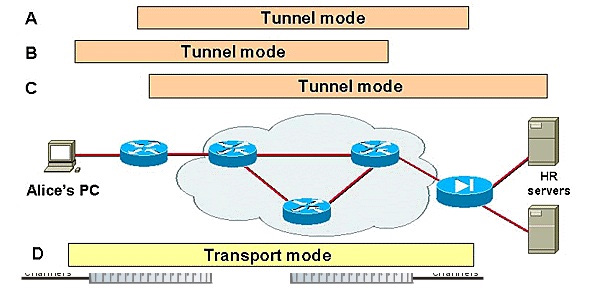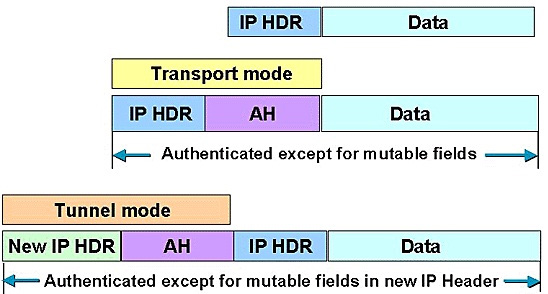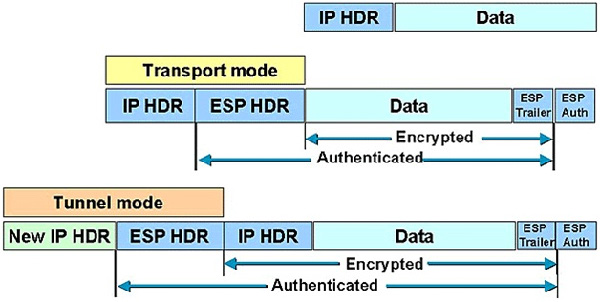Which of the following statements pertaining to IPSec is incorrect?
A. A security association has to be defined between two IPSec systems in order for bi-directional communication to be established.
B. Integrity and authentication for IP datagrams are provided by AH.
C. ESP provides for integrity, authentication and encryption to IP datagram’s.
D. In transport mode, ESP only encrypts the data payload of each packet.
A. A security association has to be defined between two IPSec systems in order for bi-directional communication to be established.
B. Integrity and authentication for IP datagrams are provided by AH.
C. ESP provides for integrity, authentication and encryption to IP datagram’s.
D. In transport mode, ESP only encrypts the data payload of each packet.
Correct Answer: A
Explanation:
Explanation:
This is incorrect, there would be a pair of Security Association (SA) needed for bi directional communication and NOT only one SA. The sender and the receiver would both negotiate an SA for inbound and outbound connections.
The two main concepts of IPSec are Security Associations (SA) and tunneling. A Security Association (SA) is a simplex logical connection between two IPSec systems. For bi-directional communication to be established between two IPSec systems, two separate Security Associations, one in each direction, must be defined.
The security protocols can either be AH or ESP.
The explanations below are a bit more thorough than what you need to know for the exam. However, they always say a picture is worth one thousand words, I think it is very true when it comes to explaining IPSEC and it’s inner working. I have found a great article from CISCO PRESS and DLINK covering this subject, see references below.
Tunnel and Transport Modes
IPSec can be run in either tunnel mode or transport mode. Each of these modes has its own particular uses and care should be taken to ensure that the correct one is selected for the solution:
Tunnel mode is most commonly used between gateways, or at an end-station to a gateway, the gateway acting as a proxy for the hosts behind it.
Transport mode is used between end-stations or between an end-station and a gateway, if the gateway is being treated as a host—for example, an encrypted Telnet session from a workstation to a router, in which the router is the actual destination.
As you can see in the Figure 1 graphic below, basically transport mode should be used for end-to-end sessions and tunnel mode should be used for everything else.
FIGURE: 1

IPSEC Transport Mode versus Tunnel Mode
Tunnel and transport modes in IPSec.
Figure 1 above displays some examples of when to use tunnel versus transport mode:
Tunnel mode is most commonly used to encrypt traffic between secure IPSec gateways, such as between the Cisco router and PIX Firewall (as shown in example A in Figure 1). The IPSec gateways proxy IPSec for the devices behind them, such as Alice’s PC and the HR servers in Figure 1. In example A, Alice connects to the HR servers securely through the IPSec tunnel set up between the gateways.
Tunnel mode is also used to connect an end-station running IPSec software, such as the Cisco Secure VPN Client, to an IPSec gateway, as shown in example B.
In example C, tunnel mode is used to set up an IPSec tunnel between the Cisco router and a server running IPSec software. Note that Cisco IOS software and the PIX Firewall sets tunnel mode as the default IPSec mode.
Transport mode is used between end-stations supporting IPSec, or between an end-station and a gateway, if the gateway is being treated as a host. In example D, transport mode is used to set up an encrypted Telnet session from Alice’s PC running Cisco
Secure VPN Client software to terminate at the PIX Firewall, enabling Alice to remotely configure the PIX Firewall securely.
FIGURE: 2

IPSEC AH Tunnel and Transport mode
AH Tunnel Versus Transport Mode
Figure 2 above, shows the differences that the IPSec mode makes to AH. In transport mode, AH services protect the external IP header along with the data payload. AH services protect all the fields in the header that don’t change in transport. The header goes after the IP header and before the ESP header, if present, and other higher-layer protocols.
As you can see in Figure 2 above, In tunnel mode, the entire original header is authenticated, a new IP header is built, and the new IP header is protected in the same way as the IP header in transport mode.
AH is incompatible with Network Address Translation (NAT) because NAT changes the source IP address, which breaks the AH header and causes the packets to be rejected by the IPSec peer.
FIGURE: 3

IPSEC ESP Tunnel versus Transport modes
ESP Tunnel Versus Transport Mode
Figure 3 above shows the differences that the IPSec mode makes to ESP. In transport mode, the IP payload is encrypted and the original headers are left intact. The ESP header is inserted after the IP header and before the upper-layer protocol header. The upper-layer protocols are encrypted and authenticated along with the ESP header. ESP doesn’t authenticate the IP header itself.
NOTE: Higher-layer information is not available because it’s part of the encrypted payload.
When ESP is used in tunnel mode, the original IP header is well protected because the entire original IP datagram is encrypted. With an ESP authentication mechanism, the original IP datagram and the ESP header are included; however, the new IP header is not included in the authentication.
When both authentication and encryption are selected, encryption is performed first, before authentication. One reason for this order of processing is that it facilitates rapid detection and rejection of replayed or bogus packets by the receiving node. Prior to decrypting the packet, the receiver can detect the problem and potentially reduce the impact of denial-of-service attacks.
ESP can also provide packet authentication with an optional field for authentication. Cisco IOS software and the PIX Firewall refer to this service as ESP hashed message authentication code (HMAC). Authentication is calculated after the encryption is done. The current IPSec standard specifies which hashing algorithms have to be supported as the mandatory HMAC algorithms.
The main difference between the authentication provided by ESP and AH is the extent of the coverage. Specifically, ESP doesn’t protect any IP header fields unless those fields are encapsulated by ESP (tunnel mode).
The following were incorrect answers for this question:
Integrity and authentication for IP datagrams are provided by AH This is correct, AH provides integrity and authentication and ESP provides integrity, authentication and encryption.
ESP provides for integrity, authentication and encryption to IP datagram’s. ESP provides authentication, integrity, and confidentiality, which protect against data tampering and, most importantly, provide message content protection.
In transport mode, ESP only encrypts the data payload of each packet. ESP can be operated in either tunnel mode (where the original packet is encapsulated into a new one) or transport mode (where only the data payload of each packet is encrypted, leaving the header untouched).
Reference:
Hernandez CISSP, Steven (2012-12-21). Official (ISC)2 Guide to the CISSP CBK, Third Edition ((ISC)2 Press) (Kindle Locations 6986-6989). Acerbic Publications. Kindle Edition. and http://www.ciscopress.com/articles/article.asp?p=25477 and http://documentation.netgear.com/reference/sve/vpn/VPNBasics-3-05.html
This is incorrect, there would be a pair of Security Association (SA) needed for bi directional communication and NOT only one SA. The sender and the receiver would both negotiate an SA for inbound and outbound connections.
The two main concepts of IPSec are Security Associations (SA) and tunneling. A Security Association (SA) is a simplex logical connection between two IPSec systems. For bi-directional communication to be established between two IPSec systems, two separate Security Associations, one in each direction, must be defined.
The security protocols can either be AH or ESP.
The explanations below are a bit more thorough than what you need to know for the exam. However, they always say a picture is worth one thousand words, I think it is very true when it comes to explaining IPSEC and it’s inner working. I have found a great article from CISCO PRESS and DLINK covering this subject, see references below.
Tunnel and Transport Modes
IPSec can be run in either tunnel mode or transport mode. Each of these modes has its own particular uses and care should be taken to ensure that the correct one is selected for the solution:
Tunnel mode is most commonly used between gateways, or at an end-station to a gateway, the gateway acting as a proxy for the hosts behind it.
Transport mode is used between end-stations or between an end-station and a gateway, if the gateway is being treated as a host—for example, an encrypted Telnet session from a workstation to a router, in which the router is the actual destination.
As you can see in the Figure 1 graphic below, basically transport mode should be used for end-to-end sessions and tunnel mode should be used for everything else.
FIGURE: 1

IPSEC Transport Mode versus Tunnel Mode
Tunnel and transport modes in IPSec.
Figure 1 above displays some examples of when to use tunnel versus transport mode:
Tunnel mode is most commonly used to encrypt traffic between secure IPSec gateways, such as between the Cisco router and PIX Firewall (as shown in example A in Figure 1). The IPSec gateways proxy IPSec for the devices behind them, such as Alice’s PC and the HR servers in Figure 1. In example A, Alice connects to the HR servers securely through the IPSec tunnel set up between the gateways.
Tunnel mode is also used to connect an end-station running IPSec software, such as the Cisco Secure VPN Client, to an IPSec gateway, as shown in example B.
In example C, tunnel mode is used to set up an IPSec tunnel between the Cisco router and a server running IPSec software. Note that Cisco IOS software and the PIX Firewall sets tunnel mode as the default IPSec mode.
Transport mode is used between end-stations supporting IPSec, or between an end-station and a gateway, if the gateway is being treated as a host. In example D, transport mode is used to set up an encrypted Telnet session from Alice’s PC running Cisco
Secure VPN Client software to terminate at the PIX Firewall, enabling Alice to remotely configure the PIX Firewall securely.
FIGURE: 2

IPSEC AH Tunnel and Transport mode
AH Tunnel Versus Transport Mode
Figure 2 above, shows the differences that the IPSec mode makes to AH. In transport mode, AH services protect the external IP header along with the data payload. AH services protect all the fields in the header that don’t change in transport. The header goes after the IP header and before the ESP header, if present, and other higher-layer protocols.
As you can see in Figure 2 above, In tunnel mode, the entire original header is authenticated, a new IP header is built, and the new IP header is protected in the same way as the IP header in transport mode.
AH is incompatible with Network Address Translation (NAT) because NAT changes the source IP address, which breaks the AH header and causes the packets to be rejected by the IPSec peer.
FIGURE: 3

IPSEC ESP Tunnel versus Transport modes
ESP Tunnel Versus Transport Mode
Figure 3 above shows the differences that the IPSec mode makes to ESP. In transport mode, the IP payload is encrypted and the original headers are left intact. The ESP header is inserted after the IP header and before the upper-layer protocol header. The upper-layer protocols are encrypted and authenticated along with the ESP header. ESP doesn’t authenticate the IP header itself.
NOTE: Higher-layer information is not available because it’s part of the encrypted payload.
When ESP is used in tunnel mode, the original IP header is well protected because the entire original IP datagram is encrypted. With an ESP authentication mechanism, the original IP datagram and the ESP header are included; however, the new IP header is not included in the authentication.
When both authentication and encryption are selected, encryption is performed first, before authentication. One reason for this order of processing is that it facilitates rapid detection and rejection of replayed or bogus packets by the receiving node. Prior to decrypting the packet, the receiver can detect the problem and potentially reduce the impact of denial-of-service attacks.
ESP can also provide packet authentication with an optional field for authentication. Cisco IOS software and the PIX Firewall refer to this service as ESP hashed message authentication code (HMAC). Authentication is calculated after the encryption is done. The current IPSec standard specifies which hashing algorithms have to be supported as the mandatory HMAC algorithms.
The main difference between the authentication provided by ESP and AH is the extent of the coverage. Specifically, ESP doesn’t protect any IP header fields unless those fields are encapsulated by ESP (tunnel mode).
The following were incorrect answers for this question:
Integrity and authentication for IP datagrams are provided by AH This is correct, AH provides integrity and authentication and ESP provides integrity, authentication and encryption.
ESP provides for integrity, authentication and encryption to IP datagram’s. ESP provides authentication, integrity, and confidentiality, which protect against data tampering and, most importantly, provide message content protection.
In transport mode, ESP only encrypts the data payload of each packet. ESP can be operated in either tunnel mode (where the original packet is encapsulated into a new one) or transport mode (where only the data payload of each packet is encrypted, leaving the header untouched).
Reference:
Hernandez CISSP, Steven (2012-12-21). Official (ISC)2 Guide to the CISSP CBK, Third Edition ((ISC)2 Press) (Kindle Locations 6986-6989). Acerbic Publications. Kindle Edition. and http://www.ciscopress.com/articles/article.asp?p=25477 and http://documentation.netgear.com/reference/sve/vpn/VPNBasics-3-05.html